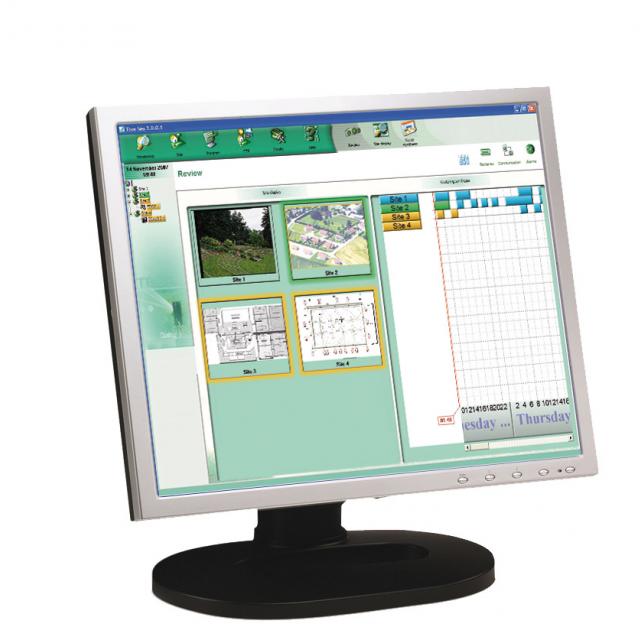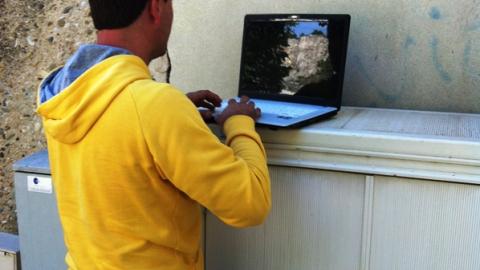A centralised irrigation control system can be described as an IT system that allows for the scheduling and management of an irrigation installation from a single location. These systems are especially designed to allow for the management of an irrigation system from one or several sites via a computer.

Centralised irrigation offers real control and automatically adapts the irrigation time in response to environmental variations (climate change, broken pipes), taking into consideration the data input by the user. This allows for the most recent technological developments to be used to save water.
The components of a centralised control system:
A centralised control system consists of irrigation management software installed on the PC, a means of communication, sensors and, of course, an automatic irrigation system. This system allows for the programmers to be controlled from a computer, thus guaranteeing a saving on water and money and removing the need to make trips to the site. The programme changes made to several controllers installed at the different sites could be carried out in only a few minutes. The irrigation time could be automatically adjusted through the installation of a weather station. The transfer of information is made via a telephone line, the Web, GSM or radio.
Communication:
There are several methods available for the communication between the PC, where the programming is carried out, and the field, where the programmers or controllers are located:
Telephone connection. In this case, the computer, which transmits the information, and the programmers located in the field are both equipped with a modem and connected to a traditional telephone line. The transfer of information is, therefore, carried out via a switched telephone network.
Cable connection. In this case, there is a physical cable connection between the two components of the central control system.
GSM link: the means of communication is achieved in this case via a GSM network. The components of the centralised management system must be fitted with a modem. This is very useful in situations where there is no telephone connection.
Automatic weather stations:
The main objective of these devices is to provide the information required to calculate the ETP and for taking into consideration the daily rainfall. They are often connected to centralised irrigation management systems used for towns or a large site such as a major sports or leisure complex. They link up the sensors (rain gauge, thermometer, soil temperature, solar radiation sensor, wind gauge, weather vane, leaf moisture sensor) with an irrigation scheduling support software. Their use allows for a central computer to calculate the necessary water applications on a daily basis, providing that the irrigation installations are properly set up in the field and that the technical parameters are entered accurately into the control system. This system, if it is well-adjusted and well-managed, will allow for the plant’s requirements to be monitored more closely.
The benefits of centralised irrigation control:
- Water saving: The centralised control systems make the management of an irrigation installation simple, precise and efficient. Centralised control allows for better water management. A number of studies have revealed that the installation of a centralised control system produces a 20% to 30% saving on water.Saving on time: the programming of a set of controllers at one or several sites requires a lot of time. Each time that a programme has to be altered or the system stopped for any reason whatever, you would need to visit the site in person. The task is made far simpler with the centralised control system.
- Easy to use: The most recent centralised management systems do not require any special technical skills. They are designed to be easy to operate and user-friendly. The end result is a saving on both time and water, with a major reduction in your labour costs.
- Maximum flexibility: a number of solutions are available, thus enabling you to select the centralised management system that is most adapted to your needs: from the smallest to the largest site, from the most basic type to the most sophisticated.
- Keeping the green spaces in good health: the centralised management systems allow for the necessary water applications to be adjusted on a daily basis according to the actual requirements of the plant, responding to environmental and natural variations (climate change, broken pipes), while taking into account the data input by the user.
- Prevention: The centralised management system monitors the water status of the site and acts to prevent the wastage of water in the case of a broken pipe, by automatically closing the valve. The monitoring of the programming and the proper functioning of the irrigation cycles is assured by the feedback provided. The printed reports enable you to monitor your water consumption in real time. It will thus be possible to predict your future requirements.
The different solutions offered by the manufacturers:
Netafim : rNET™ and uMANAGE systems
The successor to the famous IRRIWISE™ system, rNET™ retrieves the same functionality, making it an even more attractive proposition by using the classical sensors available on the market and the new uMANAGE™ central control platform.
rNET™ measures the crucial data of the irrigation system in real time: soil moisture (most sensors available on the market can be used), individual flow rates for irrigation sectors, climate data via a reliable and economical radio system (frequency used: 863-869 MHz, power: 18dBm - 70mW). It gathers and analyses data on the PC via an adaptable software package known as uMANAGE™.
For difficult radio emitter/receiver connections (distance/obstacle), the radio or cell phone relay station option will open the door to even more possibilities.
Through this Cell phone/GPRS option, it is then possible to set up the remote network with Internet access (NETAFIM™ server) on a PC and/or tablette/smartphone (Android). The NMC PRO network will be available soon.
Hunter : IMMS irrigation management software
Hunter’s renowned irrigation management and monitoring system (IMMS) makes central control affordable, usable and comprehensible.
With IMMS 3.0, the map graphic cards (at station level) provide the manager of the irrigation system with total visual control over the irrigation installations spread over a wide surface area.
IMMS is a Windows-based application that is compatible with Windows XP, Vista and Window 7 (32 or 64 bit operating systems).
With IMS-ET, you can measure the water requirements with precision and make the necessary adjustments according to the weather conditions. The optional IMMS-ET add-on uses local sensors. These sensors combine with your station database (in order to identify plant type, soil type, precipitation rates and more). You will thus have a water-saving programme for your whole system and every day IMMS-ET modelises the soil moisture content (while compensating for natural rainfall) and schedules enough irrigation water to meet the plants’ actual requirements. IMMS-ET can monitor the history via the sensors and produce a detailed report of the applications made.
Toro : Toro Sentinel centralised irrigation management system
The Toro SENTINEL system is a multi-site control system incorporating advanced water resource management facilities.
Main features: Windows-based software - Controls up to 999 field satellites - Water resource management: incorporates data taken from a weather station (ETP), flow optimisation, monitoring leaks - Multiple communication options: radio, Ethernet, telephone, GPRS, fibre optics - Connectivity to Smartphones and tablettes: remote programming, alerts - Programming: irrigation scheduling using ET information from the satellites - Integrated Turf Guard soil sensor monitoring: data relating to moisture content, temperature and soil salinity, radio system (sensors and temperature) - Portable radio remote control function - Campbell Scientific T107 or Davis Vantage Pro2 weather station, automatic ETP calculation.
The Toro Sentinel system manages 24-volt field satellites or decoders:
Sentinel Satellite: up to 48 stations, flow sensor at intake, Turf Guard receiver, Ethernet option, several types of installation options.
Sentinel Satellite decoders: up to 204 decoders, 2-wire decoders, length: 4500 metres with a 2 x 2.5 mm2 cable.
Rain Bird : IQ principle
IQ v2 is the only central control on the market designed to offer a global control solution for ESP-LXME traditional controllers, ESP-LXD decoder controllers and now TBOS-II battery operated controllers on the same software. IQ proposes the larger choice of communication with satellites: hardwire, phone, GPRS, WIFI or Ethernet. The new software option provides remote control of TBOS/TBOS-II Controllers.
The communication capabilities of IQ v2.0 virtually eliminate the need to travel to remote sites. Manual operations and programming functions previously performed at the on-site irrigation controller can now be done from the IQ central computer. Better yet, the intuitive user interface of IQ v2.0, makes monitoring your system and making adjustments easy as ever.
Save money and meet heightened water restriction with a full array of weather-based features. Advanced ET feature pack allows using WS-Pro or WS-Pro Light weather station to collect weather data and adjust run time to daily ET.

